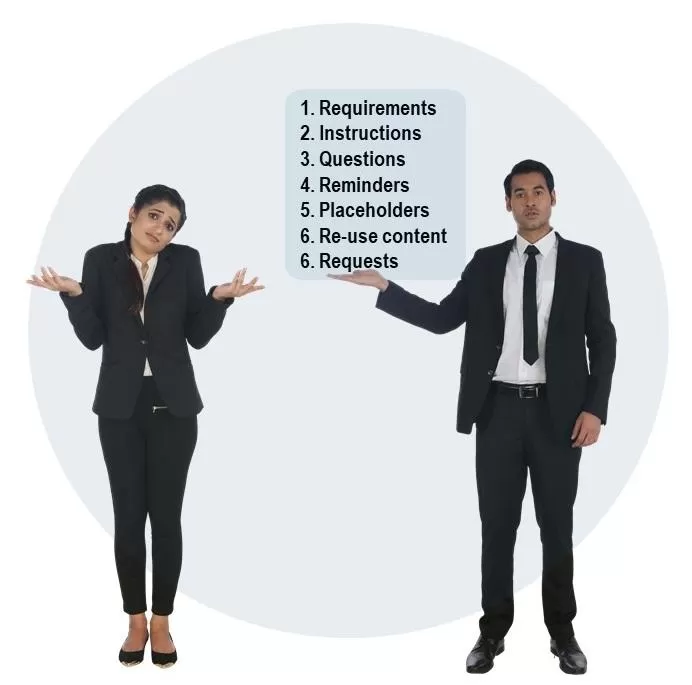Content Plans are containers. They hold ideas, instructions, and other forms of communication between proposal planners, authors, and reviewers. It’s okay if they get a little messy because you don’t want to invest too much time in making them look good when you still have to do the actual proposal. What matters is whether they set the right expectations and are helpful. This depends on who your authors are.
If you are doing a Content Plan for yourself, then you’ll know what you meant (but you may still need to make sure your reviewers do). If one person is writing the Content Plan for others to follow, then you need to make sure the instructions are clear. The more information you provide and the more clear your intentions, the better the writers will be able to meet your expectations.
How should you phrase the items in your content plan?
- Requirements. You can refer the writers to the RFP or you can drop the requirements right into the Content Plan. It may depend on how wordy the RFP is. If you have additional requirements that are not in the RFP, you can include them as well. The better job you do of accounting for or itemizing the requirements, the easier it will be to ensure compliance.
- Instructions. If you are creating a plan for others to follow, then you should word the items in your plan as instructions so that they will know what to do.
- Questions to be answered. While we prefer the clarity of instructions, another approach is to put questions into your Content Plan for the writers to answer. Also, if you have a topic that you are not sure about, rather than set it aside, you should put it into the Content Plan as a question. As the Content Plan gets passed around to authors and reviewers, they will either answer it or see that it still needs to be answered.
- Reminders. You can use the Content Plan as a container for reminders, whether they are for yourself, the team as a whole, someone specific, or unspecific. By putting it in the plan, it gets tracked.
- Placeholders. If something should go into the proposal, but you don’t have the information or content yet, you can insert a placeholder.
- Re-use content. If you have information or content that is of potential use, you can drop it into the Content Plan with instructions for how to tailor, convert, modify, or make use of it.
- Requests, issues. If you need something or have a problem, you can put that in the Content Plan as well, to ensure that the issue gets tracked.
Once the Content Plan is reviewed and the authors start writing, they can also use the Content Plan as a communication tool, pointing out things they need clarified, questions to answer, requests, or issues they encounter while completing their assignments. The Content Plan can be a way of passing messages about the writing, as well as a tool for completing the writing. While the Content Plan is in between being the initial set of specifications and a completed narrative draft, it can be passed back and forth until all of the notes and comments are resolved.
Access to premium content items is limited to PropLIBRARY Subscribers
A subscription to PropLIBRARY unlocks hundreds of premium content items including recipes, forms, checklists, and more to make it easy to turn our recommendations into winning proposals. Subscribers can also use MustWin Now, our online proposal content planning tool.


